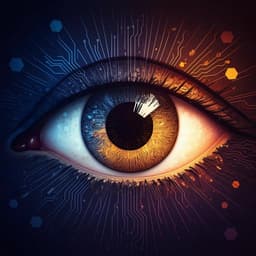
Engineering and Technology
Programmable black phosphorus image sensor for broadband optoelectronic edge computing
S. Lee, R. Peng, et al.
Explore the groundbreaking advancements in infrared image sensing developed by Seokhyeong Lee, Ruoming Peng, Changming Wu, and Mo Li at the University of Washington. Their innovative multifunctional infrared image sensor leverages black phosphorous programmable photo-transistors, allowing for efficient in-sensor computing that can recognize images with an impressive 92% accuracy, making it ideal for complex vision-sensory networks in distributed systems.
~3 min • Beginner • English
Introduction
The study addresses the need for intelligent image sensors that combine sensing and computation (in-sensor/near-sensor computing) to reduce bandwidth, latency, and power in edge machine vision systems. Two-dimensional (2D) semiconductors offer tunable bandgaps and are suitable for heterogeneous integration with photonics and microelectronics, enabling advanced optoelectronic functions. Among 2D semiconductors, black phosphorus (bP) is notable for its tunable bandgap spanning a wide infrared range, with prior demonstrations of discrete and integrated photodetectors. Multispectral imaging paired with artificial neural networks has proven powerful in biomedical imaging, agriculture/food classification, and industrial inspection but is data-intensive and latency-sensitive, motivating edge computing. Prior 2D-material-based optoelectronic edge sensors have focused on visible/UV; extending to bP enables broadband infrared intelligent sensing (including telecom bands and mid-IR) for applications such as night vision and multispectral sensing. The paper proposes a multifunctional bP-based programmable phototransistor array that performs both optical image capture and analog in-memory computation, enabling an in-sensor CNN for image recognition.
Literature Review
The authors contextualize their work within: (1) 2D semiconductors for optoelectronics with tunable bandgaps and strong light–matter interactions; (2) heterogeneous integration of 2D materials with photonic/electronic platforms; (3) black phosphorus devices demonstrating broadband IR photodetection, electro-optic modulation, waveguide-integrated detectors with high responsivity/low dark current, polarization-resolved mid-IR photodiodes, and spectrometers; (4) multispectral/hyperspectral imaging applications in biomedicine, agriculture/food quality, and industrial surface damage detection; (5) edge computing benefits for bandwidth, latency, and power in distributed sensing; (6) in-sensor/near-sensor computing concepts and prior 2D-material vision processors in visible/UV; (7) charge-trap memories and charge-trap transistors compatible with CMOS for analog in-memory computing. The present work advances this by enabling programmable, non-volatile control of both conductance and photoresponsivity in bP devices with high-precision multi-level states and demonstrating mixed-mode optoelectronic computing in the infrared.
Methodology
Device design and materials: The core device is a black phosphorus programmable phototransistor (bP-PPT) comprising a few-layer bP channel (11 nm thickness) and an Al2O3/HfO2/Al2O3 (AHA) gate dielectric stack serving as tunneling, charge storage, and blocking layers, respectively. Indium-tin-oxide (ITO) is used as a transparent top gate. Band engineering leverages electron affinity differences (χ_Al2O3 ≈ 1.5 eV, χ_HfO2 ≈ 2.5 eV) to create a high tunneling barrier and HfO2 trap levels ~1.25 eV below the conduction band to store charges with long retention. Visible light (λ < ~0.992 µm) can release stored charges, while IR in telecom bands cannot, enabling optical programming without disturbing IR sensing.
Array fabrication: Few-layer bP flakes (HQ Graphene) were mechanically exfoliated and dry-transferred onto Si/SiO2 (300 nm oxide). A flake with 20 µm × 30 µm area and 11 nm thickness was patterned via EBL and SF6 ICP etching into a 4 × 3 pixel array (each pixel 3 µm × 4 µm). Ni/Au (5 nm/25 nm) source/drain contacts were formed by EBL, e-beam evaporation, and lift-off. Processing steps involving bP were conducted in an Ar-filled glovebox (<0.1 ppm O2/H2O). The AHA stack was deposited by ALD: 6 nm Al2O3 (thermal ALD, 150 °C) as tunneling layer; 7 nm HfO2 (PEALD, 290 °C) as storage layer; 20 nm Al2O3 as blocking layer. ITO top gates were patterned by EBL and deposited by pulsed sputtering.
Electrical/optical programming and readout: Devices exhibit a large memory window (~25 V in V_G) and on/off ratio >200 with charge storage density ~1.8 × 10^13 cm^-2 (uniform across array; inter-device on/off variation <8%). Electrical programming: devices are reset by a −18 V, 50 ms gate pulse to a low-conductance state, then programmed by positive gate pulses (10–18 V amplitude, 20 ms duration) to multiple stable conductance states; linear I–V characteristics enable analog computing. Optical programming: visible (780 nm) pulses with fixed average power (~10 µW at device) and variable duration (pulse energy 10 nJ to 2 µJ) directly depopulate traps, enabling precise multi-level conductance control. Programmed states are non-volatile and can be read electrically (conductance) or optically (photoresponsivity), both in linear regime.
Spectral photoresponse characterization: Photoresponsivity was measured from 1.5 to 3.1 µm (telecom S, C, L bands and mid-IR) with a tunable IR laser (M Squared Firefly; 1.5–1.8 µm signal, 2.6–3.1 µm idler). The unmeasured 1.8–2.6 µm gap is due to source tunability. Photoresponse is linear up to ~30 mW incident power. Responsivity is programmable via trapped charge density; a low-conductance state exhibits higher responsivity (Burstein–Moss effect). Representative programmable responsivity states: ~60 mA/W (high-R) vs ~20 mA/W (low-R).
In-sensor edge detection: The array’s photoresponsivity matrix R was optically programmed to implement binary convolution kernels for right, top, left, and bottom edge detection. Input images (8-bit grayscale) were encoded as optical power at 1510 nm (S band), 1550 nm (C band), and 1590 nm (L band) and illuminated onto the array via VOAs. Photocurrent outputs I_ph ∝ R · P_in were normalized to yield convolved images without post-processing.
Optoelectronic CNN for MNIST classification: The same array’s conductance matrix g_DS was programmed (via 5-bit optical programming; 36 discrete levels) to represent weights of two 3 × 3 convolution kernels obtained by offline training on MNIST (digits “0” and “1”). Network: 28 × 28 input; single convolutional layer with two 3 × 3 kernels; average pooling; 8 × 2 fully connected (FC) layer; Softmax outputs. Training: 12,000 images, 100 epochs, achieving 99% accuracy in software with continuous weights; weights discretized to 36 levels for hardware mapping. Inference: image pixels encoded as V_DS inputs; MAC computed as I_DS = V_DS · g_DS; feature maps produced on-chip followed by pooling and FC to yield classification scores.
Measurement setup: Devices were wire-bonded to a 64-pin holder; gate/source/drain connected to SMUs for parallel readout. Optical programming used a 780 nm diode (LP785SF20). Telecom-band inputs used a tunable laser (Santec TSL-210) with VOA (EVOA1550A). A spatial light modulator enabled array-level optical programming. A CaF2 lens focused IR light for responsivity measurements. Data acquisition provided feedback to realize the network.
Key Findings
- Achieved high-density charge storage (~1.8 × 10^13 cm^-2) in HfO2 traps within an Al2O3/HfO2/Al2O3 stack, yielding a large memory window (~25 V) and on/off ratio >200 across a uniform 3 × 4 bP-PPT array (inter-device on/off variation <8%).
- Electrical programming produced at least 8 distinguishable conductance states (≥3 bits) with linear I–V and retention >2000 s; optical programming at 780 nm yielded 36 well-separated conductance levels (5-bit precision), stable >1000 s, representing record-high levels for charge-trap-based non-volatile devices within this context.
- Programmable broadband photoresponsivity from 1.5 to 3.1 µm (telecom S, C, L bands and mid-IR), with high-R (~60 mA/W) and low-R (~20 mA/W) states; linear photoresponse up to ~30 mW incident power.
- In-sensor edge detection: The array, programmed as convolution kernels, directly processed optically encoded images at 1510, 1550, and 1590 nm. Experimental convolved images matched simulations with correlation coefficients >92% across all three test images.
- Optoelectronic CNN demonstration: A 3 × 3 subarray programmed with 36-level weights implemented two 3 × 3 kernels; combined with average pooling and an 8 × 2 FC layer, it classified MNIST digits “0” vs “1”. Hardware inference on 100 test images achieved 92% accuracy (simulation with 36-level discretization: 95%; offline software training with continuous weights: 99%).
- Mixed-mode operation: Same hardware supports optoelectronic in-sensor processing and electronic in-memory computing, with both local (electrical) and remote (optical) programmability.
Discussion
The results demonstrate that storing and manipulating charge in an engineered AHA dielectric stack can non-volatilely and precisely program both the conductance and the photoresponsivity of bP channels. This dual programmability enables a unified sensor-processor platform: optical images in the infrared are captured and preprocessed via in-sensor convolution (through programmed responsivity), and subsequent inference is performed via analog in-memory MAC operations (through programmed conductance). Operating devices in the linear regime supports accurate analog MAC and aligns with low-latency, low-power edge computing goals. The infrared operation (telecom to mid-IR) extends prior 2D-material in-sensor computing beyond visible/UV, opening applications in night vision and multispectral sensing. While 5-bit analog precision is lower than digital precision, it suffices for many edge inference tasks when combined with network design and training aware of quantization, as evidenced by 92% hardware accuracy on MNIST (0/1), close to discretized simulations. The ability to program optically at visible wavelengths allows remote, selective updating of weights without perturbing IR sensing, advantageous for distributed systems. The approach is scalable and compatible with heterogeneous integration, suggesting potential to build larger, more complex optoelectronic neural networks.
Conclusion
The paper presents a multifunctional bP-PPT array that integrates sensing and computation for broadband infrared machine vision. Using an Al2O3/HfO2/Al2O3 dielectric stack, the devices achieve non-volatile, precise (5-bit) programming of conductance and photoresponsivity, enabling in-sensor convolution for edge detection of IR images and in-memory analog computation for CNN-based recognition, with hardware accuracy of 92% on a MNIST subset. The platform supports mixed-mode operation and remote optical programming. Future directions include scaling arrays (leveraging recent centimeter-scale bP growth) to megapixel sensors, enhancing spectral range and performance via heterogeneous integration with other 2D materials or thickness optimization, and employing parallel programming/imaging (spatial light modulators, wavelength-division multiplexing) to realize larger, more complex deep neural networks for distributed edge sensing applications.
Limitations
- Analog precision is limited to ~5 bits (36 levels) in the demonstrated optical programming, which is lower than digital precision and contributes to reduced accuracy compared to ideal software models (hardware 92% vs software training 99%).
- Retention for optically programmed states (>1000 s) is shorter than electrically programmed states (>2000 s).
- Demonstrations used small arrays (3 × 4 devices; 3 × 3 for CNN kernels), serving as proof-of-concept rather than large-scale deployment.
- Spectral responsivity characterization had a 1.8–2.6 µm gap due to source tunability, leaving that band unmeasured.
- Kernel weights were discretized to 36 levels, imposing quantization that impacted simulated accuracy (95%) relative to continuous weights.
Related Publications
Explore these studies to deepen your understanding of the subject.







